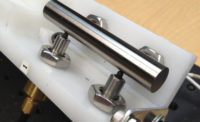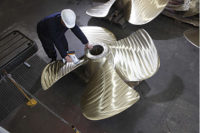
Ultrasonic spectrum analysis with a focused immersion transducer is used to evaluate grain structure in a metal axle component. Source: Olympus NDT
Ultrasonic nondestructive testing (NDT) is a versatile technique that can be applied to a variety of material analysis applications. While ultrasonic NDT is perhaps better known in its more common applications for thickness gaging, flaw detection and acoustic imaging, high frequency sound waves also can be used to discriminate and quantify some basic mechanical, structural or compositional properties of solids and liquids. Ultrasonic material analysis is based on a simple principle of physics: the motion of any wave will be affected by the medium through which it travels. Thus, changes in one or more of four easily measurable parameters associated with the passage of a high frequency sound wave through a material-transit time, attenuation, scattering and frequency content-often can be correlated with changes in physical properties such as hardness, elastic modulus, density, homogeneity or grain structure.

Ultrasonic pulser/receivers are general purpose laboratory instruments that can be used with wave analysis software. Source: Olympus NDT
Principles
Ultrasonic NDT uses the range of frequencies from approximately 20 KHz to over 100 MHz, with most work being performed between 500 KHz and 20 MHz. Both longitudinal and shear modes of vibration are commonly employed, as well as surface waves and plate waves in some specialized cases. Because shorter wavelengths are more responsive to changes in the medium through which they pass, many material analysis applications will benefit from using the highest frequency that the test piece will support.Sound pulses are normally generated and received by piezoelectric transducers that have been acoustically coupled to the test material. In most cases a single transducer coupled to one side of the test piece serves as both transmitter and receiver (pulse/echo mode), although in some situations involving highly attenuating or scattering materials separate transmitting and receiving transducers on opposite sides of the part are used through transmission mode.
A sound wave is launched by exciting the transducer with either a voltage spike or a continuous wave impulse. The sound wave travels through the test material, either reflecting off the far side to return to its point of origin (pulse/echo), or being received by another transducer at that point through transmission. The received signal is then amplified and analyzed. A variety of commercial instrumentation is available for this purpose, using both analog and digital signal processing.
An advantage of ultrasonic testing over other material analysis methods is that it often can be performed in-process or on-line. High frequency sound waves often can be successfully transmitted into and out of moving materials without direct contact, through the use of a water bath or water stream as a coupling medium. Measurements also can be performed within closed containers by coupling sound energy through the wall.
Because sound waves penetrate through the test specimen, material properties are measured in bulk rather than just on the surface. It is sometimes even possible, through the use of selective gating, to analyze just one layer of a multilayer, multi-material fabrication.
The relevant measurement parameters will typically be one or more of the following:
1. Sound velocity/pulse transit time. Sound velocity is usually the easiest ultrasonic parameter to measure. The speed of sound in a homogenous medium is directly related to both elastic modulus and density, thus changes in either elasticity or density will affect pulse transit time through a sample of a given thickness. Additionally, varying degrees of nonhomogeneity may have an effect on sound velocity.
2. Attenuation. Sound energy is absorbed or attenuated at different rates in different materials, governed in a complex fashion by interactive effects of density, hardness, viscosity and molecular structure. Attenuation normally increases with frequency in a given material.
3. Scattering. Sound waves reflect from boundaries between dissimilar materials. Changes in grain structure, fiber orientation, porosity, particle concentration and other microstructural variations can affect the amplitude, direction and frequency content of scattered signals. Scatter effects also can be monitored indirectly by looking at changes in the amplitude of a backwall echo or a through-transmission signal.
4. Frequency (Spectrum) content. All materials tend to act, to some degree, as a low-pass filter, attenuating or scattering the higher frequency components of a broadband sound wave more than the lower frequency components. Thus, analysis of changes in the remaining frequency content of a selected broadband pulse that has passed through the test material can track the combined effects of attenuation and scattering as described earlier.
In some applications ultrasonic data such as velocity can be directly used to calculate properties such as elastic modulus. In other cases, ultrasonic testing is a comparative technique, where in order to establish a test protocol in a given application it will be necessary to experimentally evaluate reference standards representing the range of material conditions being quantified. From such standards it will be possible to record how sound transmission parameters vary with changes in specific material properties, and then from this baseline information it will be possible to identify or predict similar changes in test samples.

Sound velocity is measured in material test samples with a portable ultrasonic flaw detector. Source: Olympus NDT

